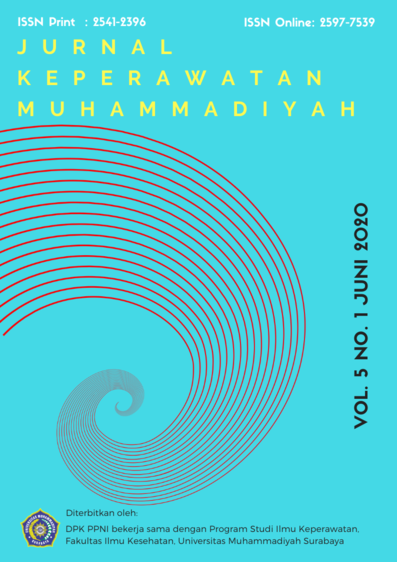Efektivitas Getah Pohon Jarak Cina Terhadap Perkembangan Kolonisasi Bakteri Luka Insisi Pada Hewan Coba Mus Musculus Strain Balb/C
DOI:
https://doi.org/10.30651/jkm.v5i1.1981Keywords:
Bencana. Luka Insisi. Getah Pohon Jarak Cina. BioplacentonAbstract
The purpose of this study was to determine the effectiveness of Chinese jatropha sap on the development of incision wound bacteria colonization in experimental animals Mus musculus Strain Balb / cThe design of this study used a true experiment post only control group design by administering Chinese jatropha tree sap to male mice (bal mus / musculus) strains aged 2 to 2.5 months and weighing 20-30 grams with a total of 30 mice. Mice made incision wounds and observed the number of colonies in the inflammatory and proliferation phases of Chinese jatropha sap and compared with bioplacentons
The results of the study in the treatment group were 410 bacteria on average while the control group were 585 bacteria in the inflammatory phase. Furthermore, in the proliferation phase the treatment group averaged 39 bacteria while in the control group there were an average of 79 bacteria. Independent t-test results in the inflammatory phase showed that р = 0.042 <α = 0.05 Furthermore, in the proliferation phase р = 0.041 <α = 0.05, in both phases there was an effect of giving Chinese jatropha tree sap to the amount of bacterial colonization in animals try Mus musculus Strains Balb / c.
Chinese jatropha tree sap contains alkaloids, saponins, flavonoids, tannins, and anti-microbial β-lactams so as to stop the development of bacterial colonies in wounds. It is hoped that the Chinese jatropha sap can be an alternative in the initial treatment of open wounds and incisions in the limitations of medicine when a disaster occurs.
References
Ahern, M., Kovats, R. S., Wilkinson, P., Few, R., & Matthies, F. (2005). Global Health Impacts of Floods : Epidemiologic Evidence. Epidemiologic Reviews, 27, 36–46. doi:10.1093/epirev/mxi004
Benedict, K., & Park, B. J. (2015). Invasive Fungal Infections after Natural Disasters. Emerging Infectious Disease, 20(3), 349–355.
BNPB. (2012a). Pedoman Umum Desa/Kelurahan Tangguh Bencana.
BNPB. (2012b). Buku Saku Tanggap Tangkas Bencana.
BNPB. (2015). Rencana Nasional Penanggulangan Bencana.
De, A., Morey, P., Jg, S., Bp, M., Angel, D., & Hospital, C. G. (2008). The great debate over iodine in wound care continues : a review of the literature. Wound Practice and Research Journal, 16(1).
Depkes. (2001). Pedoman Penanggulangan Masalah Kesehatan akibat Kedaruratan Kompleks.
Guha-sapir, D., Hoyois, P., & Below, R. (2014). Annual Disaster Statistical Review 2014 The numbers and trends.
IDEP. (2007). Panduan Umum Penanggulangan Bencana Berbasis Masyarakat.
Kemenkes. (2015). Rencana Strategis Kementerian Kesehatan Tahun 2015-2019.
Lemonick, D. M. (2011). Epidemics After Natural Disasters. American Journal od Clinical Medicine, 8(3), 144–152.
Lockwood, J. S., & White, W. L. (2011). THE USE OF PENICILLIN IN SURGICAL INFECTIONS. Annals of Surgery, 311–344.
Murray, C. K., Hinkle, M. K., & Yun, H. C. (2008). History of infections associated with combat-related injuries. The Journal of trauma, 64(3 Suppl), S221–31. doi:10.1097/TA.0b013e318163c40b
Pandey, B., & Okazaki, K. (2011). Community Based Disaster Management : Empowering Communities to Cope with Disaster Risks. Disaster Management.
Rodriguez, M. (2010). Bite Wound Infections. Emerging Infectious Disease, 10(1).
Stashak, T. (2010). Management Practices that Influence Wound Infection and Healing. Wound Care and Scar Management Journal.
Victoria, L. P. (2000). COMMUNITY BASED DISASTER MANAGEMENT IN THE PHILIPPINES: MAKING A DIFERENCE IN PEOPLE’S LIVES. Disaster Preparedness, 0–8.
WHO. (2014). Prevention and Management of Wound Infection.
Wibowo, N.A., (2017). Pengaruh Getah Tunas Pisang (Musa paradisiaca var. sapientum) Terhadap Perkembangan Koloni Luka Bakar Grade II Pada Mencit (mus musculus). Jurnal Keperawatan Muhammadiyah 2 (2) vol. 2017.
Wibowo, N.A., (2017). Pengaruh Olesan Minyak Cengkeh (Syzygium Aromaticum L). Terhadap Proses Penyembuhan Luka Insisi Pada Hewan Coba Mencit (Mus musculus). Jurnal Keperawatan Muhammadiyah 2 (2) vol. 2017.
Wibowo, N.A., 2017. Peran Postaga Dalam Pemberdayaan Kesiapsiagaan Masyarakat Dalpenang Sampang. Aksiologiya: Jurnal Pengabdian Kepada Masyarakat. Vol 1, No.2. hal 119-125
Wuthisuthimethawee, P., Lindquist, S. J., Watters, D., & Gruen, R. L. (2014). Wound Management in Disaster Settings. World Journal of Surgery. doi:10.1007/s00268-014-2663-3
Zourgui, L. (2008). Community-Based Disaster Management. Flash Flood Early Warning System Reference Guide (pp. 1–16)
Downloads
Published
Issue
Section
License
- Penulis tetap memegang hak atas karyanya dan memberikan hak publikasi pertama kepada jurnal ini yang secara simultan karya tersebut dilisensikan di bawah:Â Creative Commons Attribution-ShareAlike 4.0 International (CC BY-SA 4.0)













